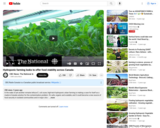
This video outlines some examples of agricultural technology that is changing farming production.
- Subject:
- Agriculture Production
- Agriculture Studies
- Material Type:
- Open Access Asset
- Author:
- Tech Shoot
- Date Added:
- 06/24/2024

This video outlines some examples of agricultural technology that is changing farming production.

In agriculture, it is important to have healthy soils. Learn how the laboratory at Dairy One analyzes soils and why the information they gather is vital to growers.

As climate chaos increases around the world, Michelle Week, a farmer outside of Portland Oregon is drawing on her Sinixt indigenous knowledge to adapt her farm to the changing seasons. By practicing techniques like seed saving and dry farming, Michelle is combating the increasing food security crisis while continuing to provide fresh food to her local community.
Women of the Earth is a new show on PBS Terra, produced by Summer Moon Productions, featuring stories of women across America who are leading a new movement to restore and protect the land. By focusing on women in land stewardship roles like farmers and shepherds, the series will explore women’s unique relationship to the earth and their innovative undertakings to heal the earth from climate change.

"The modern combine harvester, or simply combine, is a versatile machine designed to efficiently harvest a variety of grain crops. The name derives from its combining three separate harvesting operations—reaping, threshing, and winnowing—into a single process. Among the crops harvested with a combine are wheat, oats, rye, barley, corn (maize), sorghum, soybeans, flax (linseed), sunflowers, and canola. The separated straw, left lying on the field, comprises the stems and any remaining leaves of the crop with limited nutrients left in it: the straw is then either chopped, spread on the field and plowed back in or baled for bedding and limited feed for livestock.
Combine harvesters are one of the most economically important labour-saving inventions, significantly reducing the fraction of the population engaged in agriculture."

This video focuses on the functions and features of a John Deere air seeder. It was used to show field crop equipment advances.

How does climate change affect agriculture? A changing climate makes growing conditions more difficult. This video by Syngenta talks specifically about how soil impacts agriculture and how soil improvements will be key to agriculture with climate change.

Short animation showing the grain drying process of MECMAR mobile grain dryers. Such dryers are flexible, reliable, and easy-to-use machines suitable for drying grain, corn, wheat, rice, sorghum, and oilseed rape.

Students will practice math skills while becoming familiar with the uses of Iowa corn.

A corn planter has to consistently put millions of seeds at the right depth and spacing. How does it do it? Joe Ligo looks inside a 4-row Kinze planter to find out.

A Parkview paramedic shares the best items to keep in your vehicle in case of an emergency.

Meghan Vankosky, Entomologist with Agriculture and Agri-Food Canada, breaks down sweep net technique in this how-to video series.

University of Illinois Energy and Environmental Stewardship Educator Duane Friend talks about how to read soil test results and use them to monitor your soil nutrient levels.

Second in a series of videos from Khan Academy and 23andMe, this video introduces human prehistory, this video describes how our human ancestors spread throughout Africa and then into other regions such as Australia and Europe. How did they reach Australia so early on? What happened when our ancestors encountered Neanderthals?

Third in a series of videos from Khan Academy and 23andMe that introduces human prehistory, this video describes how early humans continued to defy the odds and populated the Americas during the last ice age.

Fourth in a series of videos from Khan Academy and 23andMe that introduces human prehistory, this video describes how agriculture changed human societies and genetics throughout the world.

This award-winning video collaboration from Khan Academy and 23andMe introduces human prehistory starting over 200,000 years ago. Who were our first human ancestors? Where did they live?

High-tech hydroponic urban farming is making a case for itself as a made-in-Canada solution for food stability. It's safe, organic, and scalable, and it could become a new source of food security in isolated communities and major cities.
This video from CBC News looks at how hydroponic farming is being used.

Students will be able to connect their knowledge of pH to real life agricultural applications, and understand the importance of pH requirements for Iowa crops.

Grain farmer Jeff Frey has used no-till on his 700-acre farm in Willow Street, Penn., since the 1980s. Despite these efforts, Frey knew he needed to do more to protect his soil from erosion. Recently, he worked with Sjoerd Duiker, associate professor of soil management at Penn State University, on a SARE grant designed to promote cover crops on grain and vegetable farms in their state. His story demonstrates that SARE grants encourage farmers and researchers to partner with each other to advance the adoption of sustainable agriculture practices.

More and more Indigenous communities are looking into agriculture as an economic opportunity and what it means for First Nation’s people and their future.
In this video, the leaders of Pelican Lake First Nation talk about the positive effects farming has had on their community including the creation of jobs and the long-lasting benefits for their younger generation.